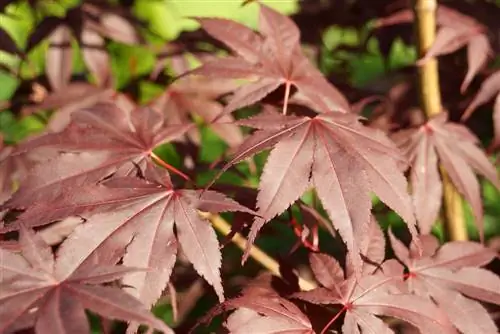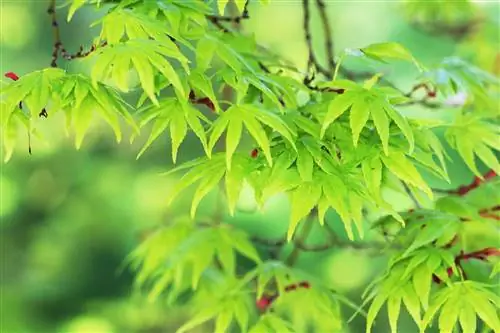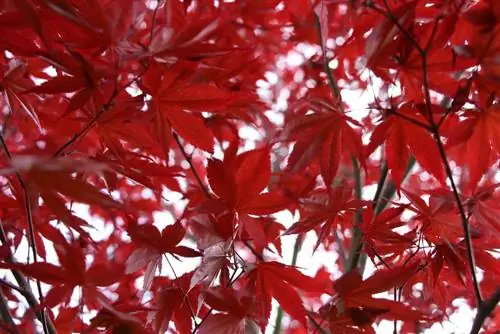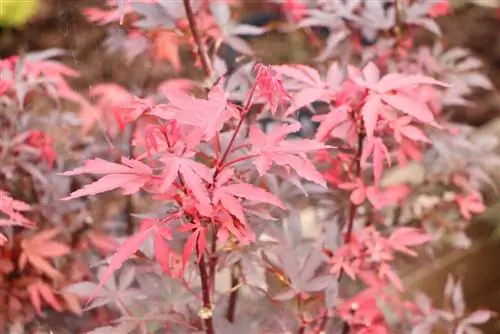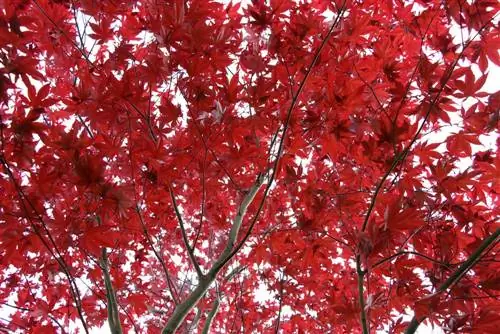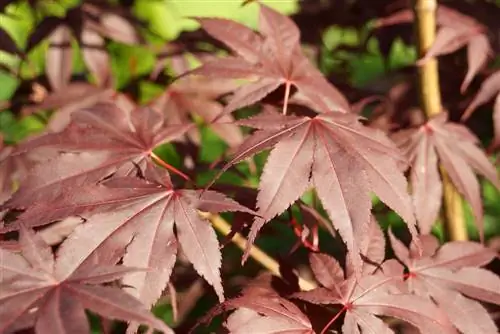- Author admin [email protected].
- Public 2023-12-17 03:39.
- Last modified 2025-01-24 12:45.
The red maple got its name because of its beautiful, intense autumnal red color. However, this tree is only suitable for large gardens with lots of space, as it can grow to between 20 and 30 meters high. The tree originally comes from North America, but is becoming increasingly popular in local latitudes for parks and larger areas, especially as a source of shade. Because it is easy to care for and hardy and requires little water and fertilizer.
Location
Red maple likes it bright, but ideally not in the blazing sun. Partial shade and protection from the wind is preferred here. Since it is a very good source of shade, the suitable location is near a seat in the garden or near the terrace. However, attention should also be paid to the later height that the fully grown tree will reach. The tree also has the property of not having deep roots but wide roots in all directions. Therefore, when planting, care should be taken to ensure that the roots do not damage walls, underground pipes or the like.
Substrate & Soil
A loamy, sandy soil is perfect for the red maple. Above all, this should fulfill the following properties:
- nutritious and light
- good storage capacity for water
- permeable, without waterlogging
- slightly acidic to slightly alkaline and moderately calcareous
- If the soil is too moist, it must be treated with peat or sand
- In wet soils, gravel can also be mixed in for better drainage
Plants
The new tree is ideally planted in spring when frosty nights are no longer expected. Once the right location has been found, the planting hole for the red maple must be prepared:
- Loosen the soil to a depth of about 50 cm
- put excavated soil into a wheelbarrow
- Add peat, gravel or sand
- place a 10 cm thick drainage layer made of gravel, pottery shards or stones in the planting hole
- Insert the young tree and fill the hole all around with the prepared soil
- Spread blue corn around the trunk and water moderately
Tip:
So that the young plant can grow stably, use a stick and tie it lightly so that no damage can occur to the young trunk.
Watering & Fertilizing
The red maple can tolerate short, dry periods quite well. If there is prolonged drought in the summer months or if the weather is very dry in winter, watering is necessary from time to time. Otherwise, natural rain is completely sufficient. When watering, proceed as follows:
- ideally in the evening hours
- pour onto the root ball
- However, avoid waterlogging at all costs
A red maple is also undemanding when it comes to fertilization. Here it is sufficient if the tree is supplied with a slow-release fertilizer, such as blue grain, once a year in spring. This one-time fertilization is sufficient for the whole year and the growth phase in summer. Long-term fertilizers have the property of slowly dissolving in water and thus releasing their active ingredients to the plants over a longer period of time.
Cutting
A red maple tree does not need regular pruning, but if it becomes too large, it can definitely be pruned back. However, it should be borne in mind that the tree does not easily forgive a radical cut. Therefore, if overall growth is to be restricted, it is better to prune a little every year than to cut too much in one year. The editing process is therefore as follows:
- always choose the warm summer for a cut
- if cut in autumn, fungal infestation may occur at the interfaces
- only cut shoots or individual branches for correction
Tip:
A red maple naturally has a beautiful growth habit that usually doesn't need any help. If the location is chosen from the start so that the tree has enough space even when fully grown, it does not need to be cut at all.
Propagate by sowing
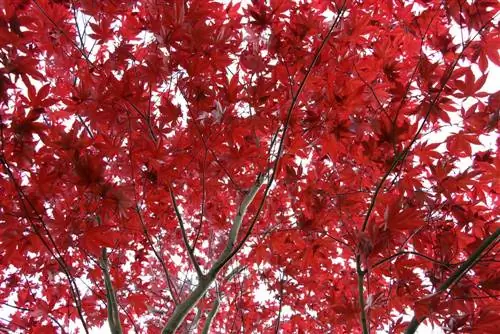
The red maple is propagated by sowing. It is usually the case that the tree forms the seeds and thereby reproduces itself. But this creates many small new trees that grow in the immediate vicinity of the existing tree and could compete with it. The seeds germinate quickly and take root. If one of these new red maple plants is to be cultivated elsewhere in the garden, it should be transplanted as early as possible, otherwise the roots will become too strong and a lot of force will have to be used in such a case. Otherwise, a red maple can also be sown as follows:
- Seeds are in a wing case
- carefully remove it
- the best time for sowing is September
- fill a glass with damp cotton wool and put a seed in it
- germination time is approximately one week
- then place the seedling in potting soil in a small pot
- keep it bright and cool, avoid direct sun
- After a few weeks, put it outside in a shady and wind-protected place
- a corner on the terrace is ideal for this
- next spring the small tree can be planted in its final location
Tip:
If many new small offshoots appear around the existing tree, they should be removed if they cannot find a new place elsewhere in the garden. Because these offshoots also develop into stately trees over time and over time take away the habitat of the old red maple.
Wintering
The red maple is hardy and deciduous. It does not require any special care in winter. However, if the tree was grown in a pot, it should be removed from it over the winter and planted in the garden. Because the roots are much more sensitive to frost in the pot than in the open ground.
Care errors, diseases or pests
A red maple is not susceptible to pests or diseases. But care mistakes can get to him. For example, if it stands on soil that is too wet, it can suffer from fungal infestation. Powdery mildew and leaf spots indicate that the tree is too dry; dry leaf tips appear if the red maple is not protected from the wind. It can only be attacked by aphids or spider mites, which can be easily controlled with appropriate commercial products.
Maple trees are highly susceptible to verticillium wilt, a fungal disease that invades the plant from the ground. The fungus is often introduced into new plantings. You can recognize the infestation by the wilted leaves. Newly sprouted shoots suddenly show wilted leaves. The leaves are limp and have an unhe althy pale green color. Branches are also affected. The fungus clogs the water pipes. You can't fight him directly. Prevention is best. This includes maintaining the culture conditions as optimally as possible. Plant tonics can also be used. Lowering the pH value can reduce the risk of infection. The permanent bodies can be killed by professional composting. Usually the only option is to cut affected branches and shoots back to the he althy wood.
Conclusion
If you have a large, free garden, you are welcome to cultivate this beautiful tree here. Because of its size, it requires a lot of space. But it is also very easy to care for and requires only a little fertilizer, moderate watering and ideally no pruning. The red maple got its name because of its bright red autumn color. It is ideal as a shade provider.
What you should know about the red maple in brief
Location
- The red maple requires a sunny to light shade location.
- He likes it warm to cool. It is good if the tree is somewhat sheltered from the wind.
Planting substrate
- The soil should be fresh to moist and of very high quality.
- The tree likes medium to deep planting substrate.
- Soil compaction endangers the development of maple trees.
- The ideal pH value of the soil is between 5.0 and 6.5. It does not tolerate lime.
- The red maple grows particularly well on nutrient-rich, acidic soils.
- On calcareous and dry soils, the red maple hardly shows its bright autumn colors.
Watering and fertilizing
- The red maple does not tolerate high heat very well. He doesn't like dry air or soil.
- The plant ball should always be kept moist to wet. However, the tree tolerates flooding well.
Wintering
Young red maple trees are vulnerable to late frost. Older trees are frost hardy
Cutting
- If you plant a maple tree, you should know that it's best to just let it grow. Almost all maple species do not want to be cut.
- The trees become susceptible to mildew and other diseases.
- If the red maple needs to be cut, it is best to do so when the vegetation begins to rest.
- Then the sap pressure is low, this is important because the tree tends to lose a lot of sap.
- Tree wax can be used to cover the wounds. This way the tree can't bleed to death.
Propagation
- The red maple can be propagated by seeds and cuttings.
- For pre-treatment, the seeds are poured with hot water.
- You place them in a moist substrate for about three to four months and store them at 2 to 5 ˚C in the refrigerator or cold house.
- In principle, you can sow all year round. But the best time is autumn or winter.
- To do this, place the seeds about a centimeter deep in potting soil plus sand or perlite or in coconut hum.
- The ideal temperature for germination is 18 to 20 ˚C.
- The planter is placed in a bright place, the plant substrate should always be slightly moist, but not wet.
- The germination time takes approx. 3 to 6 weeks. During the growing season you have to water the plants regularly.
- You don't plant the tree in the first year. You can overwinter it brightly, at 5 to 10 ˚C.
- Then it can be planted in standard soil mixed with sand or perlite. Older specimens can be planted out.

